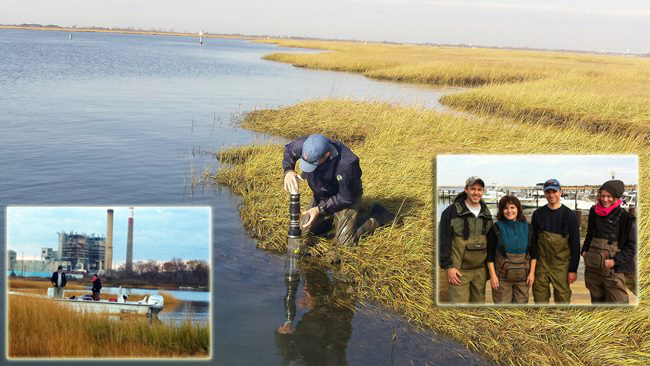NYSG Responds Quickly to Sandy Aftermath

Researchers took water and sediment samples from salt marshes near the
failed sewage treatment plant. Photos: Barbara A. Branca/NYSG
New York, NY, April 1, 2014 - Perhaps no greater example of coastal infrastructure devastation was the failure of the Bay Park Sewage Treatment Plant in East Rockaway, NY, where Sandy’s storm surge sent nine feet of saltwater into the facility, causing the damaged plant to allow an estimated 68 million gallons of raw sewage to flow into the Western Long Island South Shore (WLISS) estuary.
While repairs were being conducted, partially treated sewage continued to be released into the estuary. The plant is capable of only secondary treatment, leaving high nitrate levels in the wastewater effluent and contributing to deteriorating water quality.
Over a year later, media attention continues and has further increased public pressure to improve the aging facility and protect the estuary.
A NYSG-funded research project led by
Dr. Chester Zarnoch has provided data to show the extent to which the ecosystem could handle the additional sewage. The researchers compared the amount of nitrogen, hydrogen sulfide and dissolved oxygen from samples taken from salt marshes within sight of the plant and at a control site.
Results showed the nutrients and decomposition associated with the sewage did not result in abnormal dissolved oxygen or nitrate concentrations at the impacted study site, suggesting that sewage and nutrients were likely flushed out of the estuary before degrading water quality. Alternatively, results suggest that this site, which is chronically enriched with nitrogen, may be influenced by other nitrogen inputs from nearby creeks and non-point sources rather than solely the plant’s effluent.
By sampling in each season, the researchers determined that ecological impacts of the sewage release were likely moderated because whe Sandy struck in late October 2012 water temperatures were relatively low and dissolved oxygen levels were high. If a similar event were to occur in late summer (as did Hurricane Irene), when water temperatures and sediment respiration rates are higher, there may have been more severe impacts on the ecosystem leading to hypoxia.
Evidence suggests that salt marshes play a significant role in nitrogen removal in the estuary. Any future management plans to upgrade the facility should include the conservation of existing marshes and restoration of degraded ones. The researchers have shared this information with the USGS in collaboration with their work with the EPA and will be presenting to stakeholders and researchers at an upcoming national conference.
For more, see our in-depth feature from November 2013, "
On Blog: Can Salt Marshes Handle Effluent From a Failed Sewage Treatment Plant?" which includes a detailed in-the-field
blog entry by NYSG's Communications Manager
Barbara A. Branca.